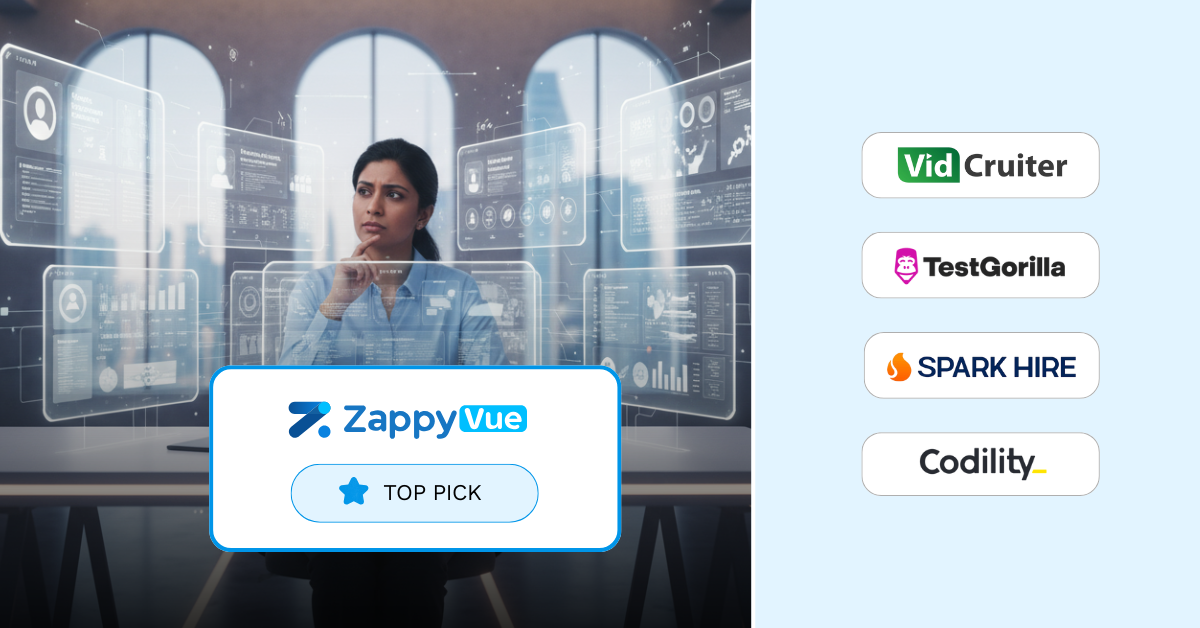
The world is saturated with data and it’s everywhere!
But amidst this abundance, how many of us actually leverage it?
We aren’t just talking about numbers. Data in general is a crucial guide that shows us how we’re doing, highlighting areas of improvement, thereby enabling us to strategize for the future.
In the recruitment landscape, however, it’s a lifeline that most of us don’t realize we need. This vast pool of information is pivotal for shaping strategies and staying ahead in talent acquisition.
Even if the desire of wanting to be a “data-driven” organization takes shape, how many organizations can actually or even know how to follow through with it?
Here’s your answer-
As per a study conducted by Forrester, 74% of firms say they want to be “data-driven,” but only 29% say they are good at acting upon the analytics.
Amidst this flood of extensive information, identifying the right data feels like searching for a needle in a haystack.
Not only is it overwhelming, it’s indeed a challenge to distinguish between what matters and what doesn’t.
But despite this, being data-driven holds immense potential for solving recruitment challenges. Identifying this potential means deciphering essential metrics and gaining actionable insights.
So if you’re in the aforementioned 29% of organizations that don’t know where to start, you might want to take notes!

What is data-driven recruitment?
Data-driven recruitment is a method that makes use of data analytics and insights in order to enhance the hiring process.
It involves an organized and systematic analysis of data at every phase of recruitment, enabling hiring personnel to make unbiased, objective and informed decisions.
Different sorts of metrics form the very core of this approach as they give recruiters substantial markers to evaluate and optimize hiring strategies.
In the case of traditional hiring, it is mostly intuition-based, where subjectivity and biases often take the lead.
In this approach to hiring, the focus is purely on objective analysis. Here’s a scenario –
A company is aiming to improve its diversity hiring practices. Through data-driven recruitment, the HR team analyzes past hiring data to gauge trends and patterns.
They identify specific stages in the recruitment process where certain demographics drop off or face barriers.
Recruiters embracing data-driven hiring meticulously monitor metrics such as time-to-hire positions, retention rates, and diversity metrics, all crucial in formulating/optimizing their recruitment strategies.
Armed with this data, they implement targeted strategies, adjust interview protocols, and refine sourcing channels.
As a result, the company may observe a significant rise in diverse hires, showcasing how data-driven recruitment can effectively address and rectify biases.
The significance of data-driven approaches in modern recruitment strategies cannot be overstated.
It’s a crucial shift, enabling organizations to make decisions grounded in quantifiable insights rather than subjective impressions.

Benefits of data-driven recruitment for effective hiring
Now that we’ve explored what data-driven recruitment actually entails, it’s time to explore the numerous benefits that accompany it.
Let’s think of this process as a magnifying glass, enabling us to really zoom in on the essential areas in hiring that we might otherwise miss out on.
These advantages play a vital role, making hiring more efficient, fairer, and ultimately more successful.
Here are some of the major benefits that come with data-driven recruitment.
- Improving quality-of-hire:
Data-driven recruitment transcends well beyond surface evaluations of the candidate. It really digs deep into skill sets, cultural fit, and key performance indicators, ensuring better candidate matches.
A study revealed that hiring based on an algorithm increases the accuracy of selecting productive employees by more than 50 %!
To imagine there are organizations still out there, gambling away productive employees by not leveraging data-driven hiring practices!
By analyzing these critical factors, recruiters significantly enhance the likelihood of finding candidates who not only meet job requirements but also align with the company’s ethos and excel in their roles.
- Reducing time-to-hire:
Currently, the average time-to-hire ranges around 44 days, which could have significant consequences on the organization. The fact the top talent doesn’t stay long in the market further adds to the problem.
Considering this, it is crucial for companies to tackle this challenge at the earliest.
Specific strategies, such as automating various recruitment processes, significantly contributes to reducing the time-to-hire, ensuring swift access to top talent.
Optimizing the hiring operations is imperative, and data-driven recruitment does precisely that.
By identifying bottlenecks, strategizing and streamlining procedures, recruiters can expect to expedite the hiring cycle.
Would you believe us if we told you that adopting highly advanced Applicant Tracking Systems like Zappyhire, can slash your time-to-hire without compromising on the quality-of-hire, to less than 11 days?
Impressive is an understatement!
- Mitigating hiring bias:
Data serves as a crucial tool in the fight against unconscious biases. It highlights hiring patterns, revealing instances of bias and providing actionable insights.
Diversity, equity and inclusion (DE&I) is a critical factor for job seekers of all ages when applying for a role.
A significant proportion of candidates – 86% – consider a company’s investment in DE&I during the process.
Identification of the problem and its root cause is half the problem solved, and that’s precisely what data-driven recruitment can help with.
By identifying these biases, recruiters can devise diversity hiring strategies to eliminate or minimize their impact, encouraging a fairer and more inclusive hiring process.
- Decreasing cost-per-hire:
$1,400. That’s how much it costs to onboard a new employee!
The stakes are high when it comes to employing individuals and it’s definitely not cheap. Therefore it is crucial that decreasing the cost-per-hire should be a priority for recruiting teams.
Here’s a figure to give you an idea about how much organizations end up spending on recruitment alone.
As per a recent report by Deloitte, staffing alone can represent up to a whopping 70% of a hospital’s cost, constituting a major recruitment challenge in the healthcare industry.
A crucial aspect of data-driven methods lies in optimizing resource allocation.
By minimizing unnecessary expenditures and formulating and implementing effective recruitment strategies, organizations significantly reduce their cost-per-hire.
To achieve this, companies can consider targeted advertising, streamlined candidate pre-screening, and more structured interview processes, all ultimately contributing to major cost savings for the organization.
- Improving candidate experience:
In recruitment, nothing trumps candidate experience!
But where does data-driven hiring come into the picture in this context?
Data-driven recruitment personalizes the candidate’s overall recruitment journey. Recruiters can tailor interactions with candidates and ensure personalization through data insights, thereby enhancing the overall experience for candidates.
A positive candidate experience not only attracts top talent but also serves as a testament to the organization’s culture and values.
A significant 60% of job seekers are unimpressed by time-consuming recruitment processes and demand that companies create a more modern recruiting experience– suggestive of the fact that there really aren’t two ways about it.

- Increasing recruiter productivity and streamlining operations:
Efficiency reigns supreme in data-driven recruitment. Any lapse in the same results in the loss of top talent- an outcome no recruiter wants!
Companies can consider streamlining operations and enhancing employer productivity, to witness amplified organizational success.
After a thorough analysis of the data pertaining to the company’s hiring operations, it would be possible for the organization to identify where exactly it is facing bottlenecks and is spending its time and resources.
Leveraging the capabilities of an Applicant Tracking System with cutting-edge tools like Robotic Video Interviews, Resume Parsers and Recruiting Chatbots, among others, will certainly aid in this endeavour, as once the load is off the recruiters they can focus on other crucial tasks.

Top data-driven recruitment strategies for informed decision-making
Even when equipped with the resources and the understanding of data-driven hiring, the path to its effective implementation isn’t as straightforward as one would think.
HR professionals navigating this landscape understand the significance of several nuanced practices that are required to successfully pull off data-driven recruitment.
These strategies are crucial to ensure that mere data collection translates to impactful decision-making. Here’s a look at them-
- Tracking key recruitment KPIs:
The first step to effective data-driven recruitment is identifying and keeping a close look at Key Performance Indicators (KPIs) specific to the hiring process.
These indicators vary across organizations but mostly include metrics like time-to-fill, cost-per-hire, quality-of-hire, applicant sources, retention rates and attrition rates.
Tracking these KPIs offers a real-time pulse on the efficiency of the recruitment team and the processes, ensuring informed decision-making throughout the hiring cycle.
Understanding and tracking KPIs provides actionable insights into various crucial aspects of hiring, thereby facilitating data-driven recruitment.
For example, a high cost-per-hire might point to inefficiencies in candidate sourcing, or interviewing processes, prompting recruiters to reassess and re-calibrate their strategies.
- Leveraging recruitment dashboards:
Recruitment dashboards transform complicated recruitment data into comprehensive and accessible visual representations.
Data is collected from various sources, offering recruiters a comprehensive overview of recruitment performance, applicant flow, conversion rates, and hiring funnel analytics.
They also help significantly in identifying trends, bottlenecks, and areas requiring immediate attention.
A recruitment dashboard provides a 360° view, allowing stakeholders to quickly interpret data trends in order to make informed decisions.
With highly advanced ATSs like Zappyhire and its innovative reporting and analytics tools, organizations can significantly boost their hiring accuracy by 72%.
Its predictive hiring model harnesses machine learning to extract insights from historical recruitment data, offering predictive hiring recommendations that streamline decision-making processes.
- Acting upon data inferences:
As mentioned earlier, data is nothing but numbers if not acted upon.
The power it wields is transformative, and it’s up to organizations to adopt this new, informed and smart (goes without saying) way of hiring.
The real value lies in interpreting and transforming data insights into actionable strategies.
Let’s say, a thorough analysis of the candidate drop-off rates at different stages of the hiring process might prompt recruiters to revamp job descriptions, alter interview techniques, or adjust communication approaches, all in order to enhance candidate engagement.
Therefore, data inferences encourage strategic decision-making, guiding recruiters towards targeted and impactful actions that improve recruitment processes.
- Analyzing before-and-after data:
This practice involves evaluating the impact of data-driven changes in recruitment strategies.
By comparing data before implementing changes and after, organizations gauge the effectiveness of their alterations.
For instance, comparing hiring metrics pre and post-implementation of an employee referral program helps assess its success and identify areas for improvement.
Analyzing before-and-after data ensures continuous improvement in recruitment strategies.
It provides insights into the effectiveness of changes made, allowing recruiters to fine-tune their strategies for optimal outcomes.
- Addressing data limitations in recruitment
Challenges in utilizing data for recruitment purposes, such as data quality issues, biases in algorithms, or limitations in data access, can hinder effective decision-making.
Addressing these limitations involves acknowledging and mitigating such obstacles to ensure the accurate and ethical use of data in recruitment practices.
Recognizing and addressing data limitations ensures the integrity and reliability of data-driven recruitment efforts.
Consider this- acknowledging biases in historical data might prompt recruiters to adjust algorithms or sourcing methods to prevent perpetuating bias in future hiring decisions.

In short,
Today, overlooking the power of data in recruitment can cost you more than you think. Data-driven practices offer a clear path toward better, fact-based decisions in hiring.
From keeping track of important indicators to analyzing trends and formulating precise strategies, leveraging data is indeed a game-changer.
But despite the countless benefits that accompany this practice, only a mere 24% of organizations are data-driven, reflective of how far we have to go.
The question is, why settle for uncertainty when you can harness the certainty of data to transform your hiring process?
And if all this insight has sparked your interest, just imagine the possibilities an applicant tracking system like Zappyhire can unfold for you.
Take a step forward and book a demo to witness firsthand the impact of data-driven solutions in revolutionizing recruitment.






